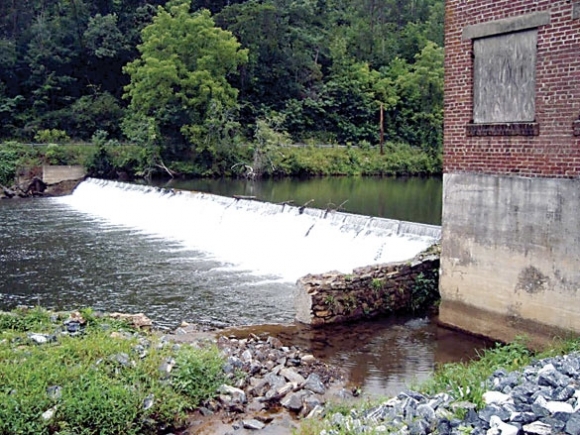Plotting Cullowhee Dam’s future: Organizations weigh environmental and financial costs of repair and removal

Nearly a century old, the aging Cullowhee Dam is at a crossroads — with risk of failure increasing, Western Carolina University must decide whether to renovate the existing structure or remove it completely.
The dam hasn’t been used for power generation since the 1960s, but it creates a reservoir of still water that supplies WCU and the Tuckaseigee Water and Sewer Authority. However, some would like to see the dam disappear, offering increased opportunity for paddlers and allowing fish and other aquatic life to travel freely through a more natural, higher-quality river.
The river conservation group American Rivers is leading that charge, and even though a preliminary estimate put the cost of dam removal at $5-$7 million, the organization isn’t giving up.
“Dam removal is something that we do really well and we’re really great at working in partnership to achieve,” said Mandi Carringer, Western North Carolina river conservation associate for American Rivers. “The price tags don’t scare us.”
The $5-$7 million estimate comes from a July report that Asheville-based McGill Associates completed at the request of WCU and TWSA to look at options for the dam’s future. A 2005 study from Sutton-Kennerly and Associates, also of Asheville, had concluded that the dam had likely been inspected only once in its lifetime and showed evidence of “severe deterioration”; failure would pose a “significant threat to life safety” and a “significant economic and operational loss” to WCU.
However, WCU didn’t go through with a full inspection of the dam until now. That’s because the idea of building a river park there started to be discussed at that time and the university wanted to ensure that any decisions about the dam lined up with still-brewing park plans, WCU Communications Director Bill Studenc told The Smoky Mountain News in 2016.
Related Items
The 2017 study included a full inspection of the dam and preliminary estimates for a variety of alternatives. And while “no action” was listed as one of the alternatives, that’s not likely to be the decision.
Results of inspection
The inspection revealed an undercut beneath the dam, possibly allowing water to flow underneath it and erode the soil away. Over time, such an undercut could allow a portion of the dam to slide or turn over. In addition, erosion at the dam’s right wall permits flow around the sidewall during heavy flow conditions — that could result in the slope and a portion of Wayehutta Road washing away.
So, something has to be done. But what that something is — dam removal, dam renovation or something in between — will depend on the outcome of a follow-up study that American Rivers is soliciting from McGill Associates.
The initial study showed that removing the dam and installing two new water intakes for WCU and TWSA would cost about $7 million, while the preferred alternative — repairing the dam to address safety and maintenance concerns — would cost about $900,000. That’s a big cost difference, and for WCU and TWSA, the outcome of the cheaper project would be more beneficial.
“The reservoir that the dam creates really gives us more drought resistance, and it gives us a better water intake,” explained Mike Byers, vice chancellor for administration and finance at WCU. “The quality of water that we pull from water that’s not moving is much better quality water than what we would pull from moving water, and therefore it has an impact on what our water intake plants have to do.”
If the water intakes were suddenly drawing from moving water instead of standing water, Byers said, there would likely be some costly unfitting required at the water treatment plant.
There’s also the question of drought. Last year was one of the driest on record, with daily mean flows at the nearest stream gauge below 300 cubic feet per second for most of the calendar year compared to a typical mean of 396 cfs. If Duke Energy hadn’t agreed to release water from the reservoir at Lake Glenville, Jackson County would have found itself in mandatory water conservation until the rain returned.
Even barring future drought, water demand is expected to rise significantly over the coming decades. Current projections show WCU’s demand increasing from an existing 0.28 million gallons on an average day to 0.754 million gallons by 2067; TWSA’s demand is expected to rise from an existing average of 1.111 million gallons per day to 2.116 by 2067.
Removing the dam — at least in the fashion that the study explored — would also remove the small reservoir of water it creates and increase the vulnerability of the water supply. Duke Energy has already said that, were that to happen, it would not be able to supplement the deficit through higher water releases as it did during the 2016 drought.
“If Cullowhee Dam is removed only to find out later the Tuckasegee River does not have enough water flow during certain periods of the year to meet the growing water supply needs of WCU, TWSA and other entities, Duke Energy would not be able to support releasing higher prescribed flows to meet those needs,” reads a March 2017 letter from Duke’s director of water strategy and hydro licensing Jeffrey Lineberger to WCU and TWSA. “In fact, Duke Energy and other signatory parties to the Settlement Agreement are contractually prevented from supporting flow prescriptions which are inconsistent with the Settlement Agreement.”
Searching for a solution
American Rivers is hopeful that there’s a solution out there that would free the river while also protecting the quantity and quality of the water supply.
“Having drinking water is very important for American Rivers,” Carringer said. “Even though we do want to see dams removed, we obviously want healthy, resilient communities and we don’t want anything to jeopardize the resiliency of our water supply.”
While obviously invested in protecting the water supply and not desiring to commit to a project it doesn’t have the ability to fund, WCU is supportive of American Rivers’ efforts and on board with taking some time to look at all the options available.
“There’s got to be some crazy number out there in the universe that would do that,” Byers said of the desire to free the river while protecting the water supply. “I don’t know how it would happen, but would a billion dollars do it? There’s bound to be some huge number and massive solution that would solve this, and it would just be out of reach — but what if it’s not out of reach? The only way to know is to allow them (American Rivers) time to go check for more expensive alternatives.”
The way Byers sees it, WCU is already in at least $900,000 to repair the dam and address safety issues there. If American Rivers could come up with a plan that got rid of the dam while protecting the university’s interests — and money to fund the difference in price — WCU would be all for it.
“That would be the best-case scenario,” Byers said. “We have as good or better a water source and we’re able to remove the dam and get rid of that maintenance need and free the river.”
Another option in the mix would be to create a notch in the top of the dam to allow paddlers to safely cross it. That’s a solution that the Cullowhee Revitalization Endeavor — known as CURVE — had supported toward its goal of turning the area around the dam and Old Cullowhee Road into a river park. But the notch would cost $1 million in addition to the cost of repair, and it wouldn’t provide the cascade of positive environmental effects that American River hopes to achieve with dam removal.
“Dams block the movement of fish and other aquatic species, inundate river habitat, impair water quality and alter the flow regime necessary to sustain river life,” Carringer said.
By removing the dam, fish would be able to move freely throughout the length of the Tuckasegee, and the warmer water and sediment-heavy riverbed now occupying the reservoir below the dam would flow cooler and clearer on its way to the Little Tennessee River.
“What American Rivers would ideally like to see would be to see a whole dam removal that does open up the river for recreation and fish passage and also has a way for us to continue drawing water from it for our community use,” Carringer said.
The organization is currently developing a scope of work for McGill Associates’ follow-up study. That scope of work will determine the cost of the study, but Carringer said American Rivers has the funding to pay for it.
In the meantime, WCU will start planning to fund the $900,000 repair project with an eye cocked toward American Rivers’ continued work on behalf of dam removal. The money would come from WCU’s existing repair and renovation fund. Last year’s allocation was over $1 million; assuming future allocations are of a similar amount, the repair project would likely be spread over multiple fiscal years to allow WCU to repair the dam while also addressing other renovation needs on campus. Byers anticipates it could be done within two to four years.
However, he’s open to pivoting the plan depending on the outcome of American Rivers’ research.
“We’ve known that we needed to do some work on the dam for many years and done some small things along the way to make sure we’re taking care of business,” he said, “but another six months to find out what a potentially ideal solution would be is definitely worth investing the time.”









